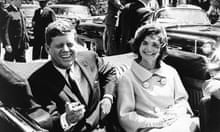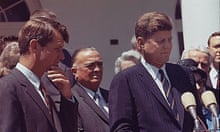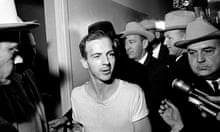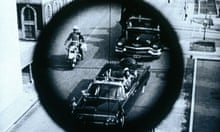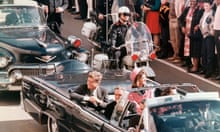The publication of nearly 3,000 previously classified files relating to the assassination of John F Kennedy in 1963 reveals that the FBI had warned Dallas police about a threat to kill Lee Harvey Oswald, and claims that Soviet officials feared an “irresponsible” US general could launch a missile strike in the wake of the crisis.
The US government released 2,891 documents on Thursday, but President Donald Trump delayed the release of others, saying he had “no choice” but to consider “national security, law enforcement and foreign affairs concerns” raised mostly by the FBI and CIA.
One of the first interesting documents to be unearthed, as journalists, scholars and the public pored over them, was a memo written by director J Edgar Hoover that said the FBI had warning of a potential death threat to Oswald, who was then in police custody.
“There is nothing further on the Oswald case except that he is dead,” Hoover said on 24 November 1963. “Last night we received a call in our Dallas office from a man talking in a calm voice and saying he was a member of a committee organized to kill Oswald.
“We at once notified the chief of police and he assured us Oswald would be given sufficient protection. This morning we called the chief of police again warning of the possibility of some effort against Oswald and again he assured us adequate protection would be given.
“However, this was not done.”
TimelineJFK's assassination
Show
President John F Kennedy is shot dead by a sniper while his motorcade moved through Dallas. Lee Harvey Oswald, a former US marine and Soviet defector, is arrested.
Oswald is shot dead by a Dallas nightclub owner, Jack Ruby.
The newly sworn in president, Lyndon Johnson, orders an investigation of the assassination, named after its leader, chief justice Earl Warren.
The Warren Commission determines that Oswald acted alone, without help from Cuba or Russia. The panel also finds that Ruby acted alone.
A new investigation by four medical experts reaffirms the commission's finding that two bullets killed Kennedy from behind.
Clay Shaw, a New Orleans businessman, is acquitted of charges of conspiracy in Kennedy's murder, after 50 minutes of deliberation. He is the only person prosecuted over the assassination.
After two years of investigation, a House committee accuses previous investigators of failing to explore sufficient leads. The panel found it "likely" that conspiracies were behind Kennedy's murder, including a possible second gunman on "the grassy knoll" in Dallas. The committee also believed organized crime was "probably" involved.
Oliver Stone premieres JFK, his film about the Shaw trial and the possibility of a CIA conspiracy, motivated in part to keep the US in Vietnam. A few months later, Seinfeld parodies the elaborate conspiracy theorizing around the Zapruder film and "magic bullet" theory.
Congress enacts the JFK Records Collection Act and orders the release of 3,100 secret documents in an attempt to quash conspiracy theories. The documents are ordered released with a 25-year deadline.
Donald Trump accuses the father of Ted Cruz of involvement in the assassination. He cites the National Enquirer, a tabloid, as his source.
Hoover admitted he did not have “firm” information about Jack Ruby, the man who shot Oswald dead. But he elaborated on the nightclub owner anyway, saying his real name was Rubenstein and noting rumors of “underworld activity”.
The FBI sent an agent to Oswald’s deathbed in the hopes of a confession, to no success. Ruby denied making any phone call to the bureau.
In the same memo, Hoover said he and Nicholas Katzenbach, the deputy attorney general, already feared the spread of conspiracy theories. He noted that Oswald had visited Mexico City, called the Cuban embassy there, and sent a letter to the Soviet embassy about a visa.
“The thing I am concerned about, and so is Mr Katzenbach, is having something issued so that we can convince the public that Oswald is the real assassin,” Hoover wrote.
The files amounts to nearly the final 1% of records held by the federal government and their publication follows a release in July when the National Archives posted 3,801 documents online, mostly formerly released documents with previously redacted portions. An administration official told reporters on Thursday that the files that remain secret have information that “remains sensitive depending on its context”.
Trump ordered the agencies to review those redactions over the course of six months, the official said, to ensure more documents reach the public. The next deadline for documents is 26 April 2018.
According to the National Archives, 88% of records related to Kennedy’s murder were already fully open and another 11% released but partially redacted. In total, that makes for about 5m pages.
The newly released documents also reveal that Soviet Union leaders considered Oswald a “neurotic maniac who was disloyal to his own country and everything else”, according to an FBI memo documenting reactions in the USSR to the assassination.
The Soviet officials feared a conspiracy was behind the death of Kennedy, perhaps organised by a rightwing coup or JFK’s successor, Lyndon Johnson.
They also feared a war in the aftermath of Kennedy’s death, according to the memo: “Our source further stated that Soviet officials were fearful that without leadership, some irresponsible general in the United States might launch a missile at the Soviet Union.”
The documents include details of various CIA attempts to assassinate foreign leaders, most frequently Cuban leader Castro. He told American lawmakers in 1978 that his country was not involved in the plot to kill Kennedy.
In 1963, however, the Cuban ambassador to the US reacted with “happy delight” to the murder, according to a CIA memo.
Other information so far uncovered includes:
- Oswald spoke to a member of a KGB assassination unit in Mexico City in September 1963. A CIA memo calls the consul there, Valeriy Vladimirovich Kostikov, “an identified KGB officer” and a member of Department 13, a unit “responsible for sabotage and assassination”.
- The Dallas division of the FBI was already trying to track Oswald in October 1963, according to memos by the New Orleans division.
- Jack Ruby had a “good in” with Dallas police, according to an FBI informant in a memo dated shortly after Ruby shot Oswald dead.
- A reporter on the UK’s Cambridge Evening News received an anonymous call telling him to ring the US embassy for some big news, 25 minutes before the assassination of JFK in Dallas.
We’d like your help too. The JFK files have been published online here. If you’re reading through the documents and you spot an interesting fact or snippet you think we’ve missed, it would be great if you could let us know. We’ve set up a form here for contributions.

